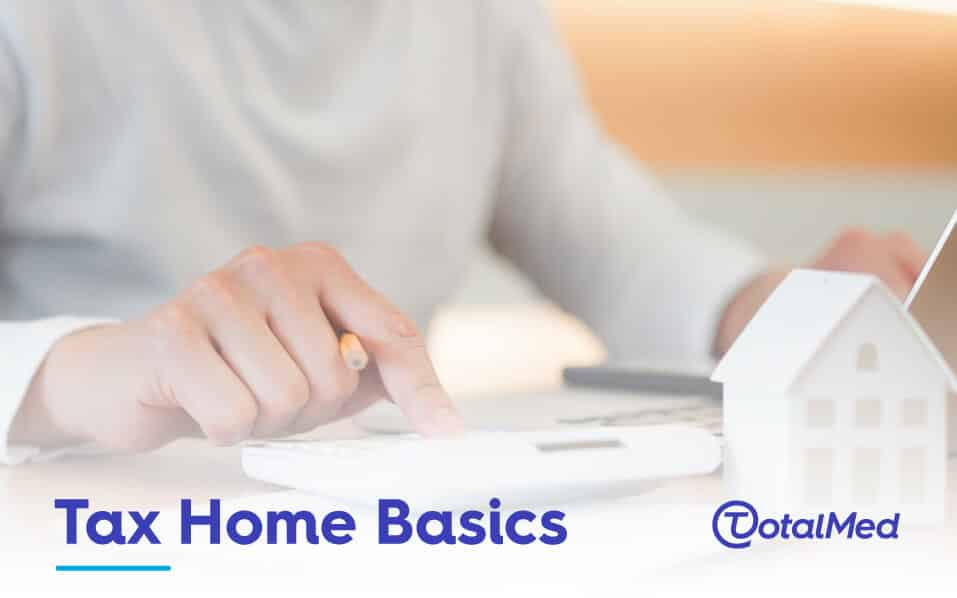The Basics to Understanding a Tax Home
Advice for travel nurses and clinicians to establish and maintain a tax home

As a travel nurse or clinician, it is important for you to establish and maintain a tax home to avoid hefty fines and back taxes and to claim travel expenses. So let’s talk through what this means.
What is a tax home?
First, note that a “tax” home is not the same as your “residence” home. The IRS describes your tax home as “the entire city or general area” of your main place of business. This is determined by the total time you spend in each place, the amount of work you do at each place, and how much money you make at each place.
Why do I need a tax home?
A tax home will allow you to reap the benefits of untaxed income such as reimbursements or stipends. Also, if you do not have a tax home, you will be considered an itinerant (transient) and will not be able to claim travel expenses on your taxes. (Itinerant workers don’t have a home and therefore are not considered to be traveling away from home.)
How do I create a tax home?
You have to meet two of the three requirements to ensure you get the deductions for your tax home and keep your untaxed income in your contract untaxed.
- Have regular business/employment in your tax home.
- Maintain a permanent residence in your tax home by paying for rent, mortgage, utilities, etc. (Remember, this is the area, not a physical home.)
- Have not abandoned your tax home.
Let’s break each of these down.
Have regular business/employment in your tax home
You will need to work and earn approximately ¼ of your income within your tax home. This satisfies both requirements 1 and 3.
Example: Jenny is a nurse in Bangor, ME. She works every summer at a local hospital there and travels the rest of the year to different locations. She never works in a single tax home more than she does in Bangor.
If you are wanting more flexibility for location and duration of assignments, it might be best to focus on meeting the second and third requirements.
Maintain a permanent residence in your tax home
Rather than income and time focused, this requirement is more expense focused. You will need to maintain significant expenses in your tax home. These expenses must be duplicated by your housing expenses when traveling.
Example: Mateo is a travel Med/Surg nurse. He and his family live in Charlotte year-round. The mortgage and utilities are in Mateo’s name, and he keeps his bank account in Charlotte. When he gets an apartment on assignment, he is duplicating housing expenses. In between assignments, during the summer and on holidays, he returns to Charlotte. By doing all of this, he satisfies requirements 2 and 3.
Establishing duplicate expenses: How you establish duplicate expenses varies based on how you keep your residence in your tax home. If your name is on the lease or mortgage, that generally is sufficient proof of home expenses. However, if you are a roommate in a dwelling in your tax home, you will need to ensure you are paying market rate for your rent and have proof that you are contributing to ALL shared living expenses.
Have not abandoned your tax home
By meeting the first and second requirements, you automatically establish that you have not abandoned your tax home and fulfill the third requirement.
How do I make sure I maintain my tax home?
Balancing your assignments in other areas is key to ensuring you do not negate your tax home.
Example: Tiana is a travel nurse with a tax home in Denver. In one year, Tiana took assignments in Sacramento, Portland, Seattle, and Orlando. She turned down a position in Bellevue, a suburb of Seattle, because it would have meant she worked more in Seattle than she did in Denver. If she had taken the Bellevue job, then Denver would no longer have been her tax home.
How long can I spend in a location that’s not my tax home?
The IRS does not specifically spell out the exact amount of time you can spend in a location that’s not your tax home and still claim a tax home. Instead the IRS reviews the last 24 consecutive months of your work history to ensure you worked a significant amount of time in your tax home or that you did not completely abandon it. They are also looking for breaks in service between assignments in any non-tax home area.
Most travel nurses avoid working in a single metropolitan area more than 12 months out of any consecutive 24 months.
Remember failure to adequately prove you have a tax home can result in thousands of dollars of fines and back taxes.
